June 2022
- English
- 日本語
Japanese Cuisine Synchronized with the Seasons

A hassun course seasonal dish for summer 
Tokuoka Kunio, executive chef of Kyoto Kitcho Co., Ltd.

View from the restaurant to the garden in summer 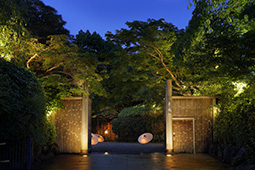
The entrance to Kyoto Kitcho 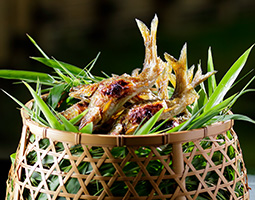
Grilled salted sweetfish, with bamboo leaves representing a river 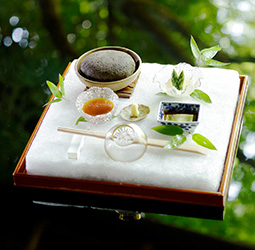
Himuro Zen, a summer course dish served on a tray of ice 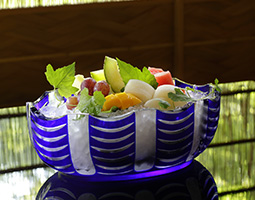
A summer fruit dish 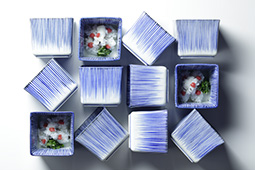
Parboiled hamo sea eel served in small dishes with a summer-themed pattern 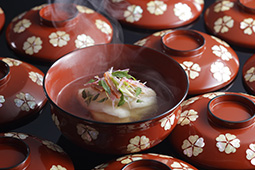
Soup bowls inlaid with cherry blossom patterns made of mother-of-pearl

Japanese people value food that expresses a sense of the season because they are keenly aware of Japan’s four distinct seasons. In particular, there are a number of long-established restaurants in Kyoto where people can enjoy such seasonal Japanese cuisine and keenly perceive the changes of the season. We introduce a famous Kyoto restaurant that seeks to express the flavors of each season with each dish.

Arashiyama is a picturesque district of Kyoto where the Togetsukyo bridge over the Katsura River* provides stunning views of the mountain slopes’ cherry blossoms in spring, deep greenery in summer, fall colors in autumn, and snowy scenes in winter. Yuki Teiichi (1901–1997), a master of Japanese cuisine, purchased a private villa in this district in 1948 and turned it into a restaurant—the now world-famous Kyoto Kitcho.

Yuki aimed to integrate the spirit of the traditional Japanese tea ceremony, which values seasonal senses, with Japanese cuisine, and is known for his lifelong pursuit of the ideal form of Japanese cuisine, including through the appropriate use of tableware and shitsurai (expressing hospitality through space and room decoration). Yuki received the Japanese government’s Medal of Honor with Purple Ribbon and Person of Cultural Merit award for his achievements in turning Japanese cuisine into an art form, respecting its long history and traditions.
Yuki’s grandson, Tokuoka Kunio, is the executive chef of Kyoto Kitcho Co., Ltd.

“Similar to waka** poets, who compare the various natural phenomena of the four seasons to human emotions, chefs of Japanese cuisine express the nuances of the seasons in each individual dish,” says Tokuoka. “For example, if we are using ayu sweetfish, a river fish caught throughout summer, then I would serve the fish in a bamboo basket with bamboo leaves placed in such a way as to suggest the flow of the river and to make the fish appear as if they were swimming. Customers are thus invited to enjoy the unique flavors of the sweetfish while getting a sense of the flow of the river in which they swim.”

Kyoto Kitcho offers a spectacular and varied course menu based on the traditional cha-kaiseki meal, which originated in the tea ceremony. There are around ten courses including the mukozuke (a vinegary dish of sliced sashimi [raw fish]), owan (soup), two kinds of tsukuri (sashimi), hashiyasume (palate-refreshing side dish), hassun (assorted appetizers), yakimono (grilled ingredients), takiawase (assorted simmered ingredients), gohan (rice), kudamono (fruit), and kashi (Japanese sweets).*** From the mukozuke course, the very first dish, Kyoto Kitcho expresses a sense of the season. In the summer season, for example, the mukozuke might be Himuro Zen, using ice in the presentation of the food, while the hassun course, served in the middle of the meal, might feature a colorful summer flower or leave a space between the food on the plate, as though a breeze were passing through. In such ways, Tokuoka expresses the four seasons with each dish he presents while making use of the beauty of the ingredients themselves and their seasonal flavors.

The tableware Tokuoka selects for each dish adds another seasonal element to the dining experience. Yuki was known as a collector of tea ceremony tools and tablewareiv, and some items among the collection have been designated as important cultural properties by the Japanese government. Tokuoka hand-picks dishes from this collection based on the season or purpose of the meal and serves the food while giving his heart to the needs of each customer.

Tokuoka is also dedicated to the spatial presentation of the dining area, picking out hanging scrolls and other decorations related to the seasons or yearly events. This is an expression of the ethos he inherited from his grandfather that Japanese cuisine is more than just ingredients or cooking and requires a comprehensive presentation just like the tea ceremony, and could be said to be a practice that attempts to elevate Japanese cuisine to the level of art.

Kyoto Kitcho offers the profound pleasure of this kind of Japanese cuisine, and the restaurant’s reputation is reflected in its international recognition, including the Michelin Guide’s three-star rating in 2021.

Note: Kyoto Kitcho course meals and tableware vary according to the season and customer.
* Togetsukyo is a 155-meter-long bridge that crosses the Katsura River, which flows from Sagano to Arashiyama. The bridge is a border for the Katsura River, with waters upstream called the Oi River.
** See Highlighting Japan, October 2020 edition (The Colors of Fall Captured in Waka Poetry) https://www.gov-online.go.jp/eng/publicity/book/hlj/html/202010/202010_02_en.html
*** At Kyoto Kitcho, dishes are served in the following order: mukozuke, owan, tsukuri. Traditional hassun is a dish consisting of a variety of small portions of food served on a plate measuring approximately 24 cm square (“has” means 8; “sun” is an old Japanese unit of length). Takiawase is a dish consisting of two or more kinds of simmered dishes served in the same bowl.
**** Tea ceremony tools and tableware collected by Yuki Teiichi are stored and exhibited at the Yuki Museum of Art in Osaka http://www.yuki-museum.or.jp

